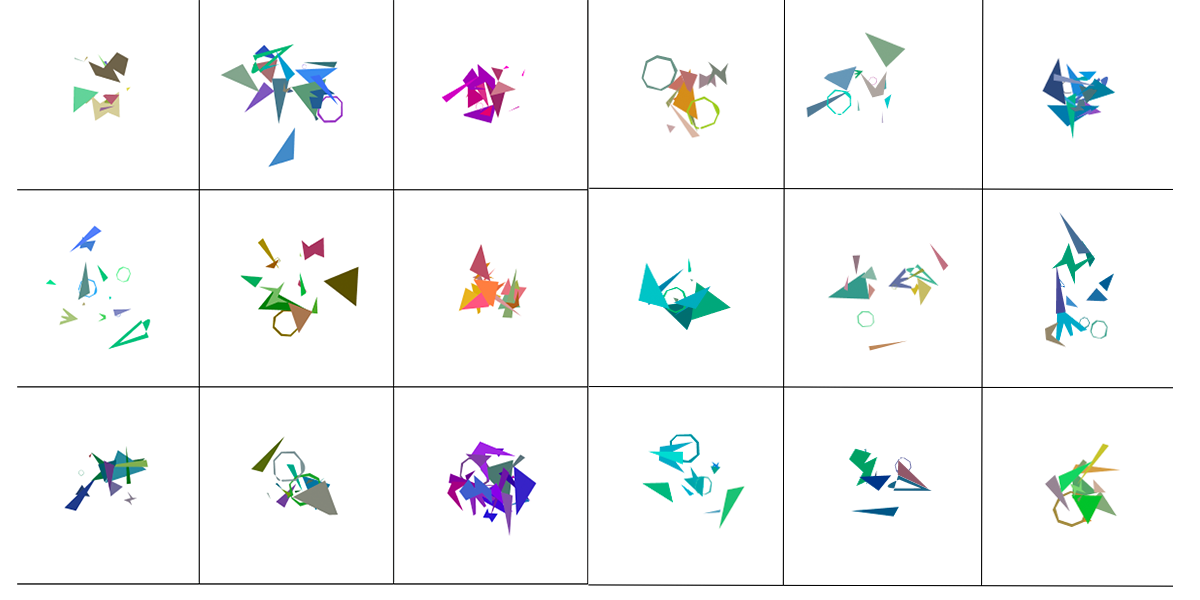UVM Art and AI Initiative

Project Information
image-processingProject Status: Complete
Project Region: Northeast
Submitted By: Northeast Cyberteam
Project Email: jkarson@uvm.edu
Project Institution: University of Vermont
Anchor Institution: NE-University of Vermont
Project Address: Vermont. 05405
Mentors: Adrian Del Maestro, Keri Toksu
Students: Ethan Davis
Project Description
The UVM Art and AI Initiative is exploring approaches to artistic image production, comparing the results of StyleGAN and Genetic Algorithms*. More broadly, the project explores emerging artistic practices with Machine Learning and AI while referencing an artistic lineage to the artists Wassily Kandinsky, Jonn Cage and Yoko Ono; these artists employ(ed) instructions and systems in their non-digital artworks. Kandinsky distinguished systems and developed a science of aesthetics with the basic elements of point, line and plane; Cage used the oracle 'I Ching' like a computer to inform his compositional decisions; Ono writes poetic scores that turn her audience into active participants when they follow a series of imaginative instructions. Through this ongoing research and practice, we intend to join the larger conversation about art and A.I and design new curriculum for UVM undergraduate students.This work began in February 2020 and is led by Jennifer Karson of UVM’s Department of Art and Art History and the CEMS UVM FabLab. The team has included three UVM students: two graduate students in data science and one undergraduate mechanical engineering student. The team currently uses RunwayML for the StyleGAN experiments and Processing, an open-source language and development environment built on top of the Java programming language, for Genetic Algorithms.
Additional summer funding ($2,000) is sought for one of the UVM Art and A.I. Initiative student coders. The funding will assist the team in reaching a short-term goal to present initial findings this July at Alife 2020 Montreal; a longer-term goal is to create an art installation for the UVM Fleming Museum of Art in the spring of 2021. This is a unique opportunity to exhibit as part of the statewide project 2020 Vision: Seeing the World through Technology and alongside the work of internationally renowned computer artist and co-founder of the Processing programming language Casey Reas.
Milestone 1:
Genetic Algorithms: Develop successful genetic algorithm code that meets compositional standard (color, architecture, appropriate datasets) while creating new compositions from the elements of existing hand-drawn compositions. The program should output image files that can be stored and printed at high resolutions on paper.
StyleGAN: Transition from RunwayML to coding in Python and employing VACC computer cluster. The process should output image files that can be stored and printed at high resolutions and on paper to be exhibited.
Milestone 2:
Genetic Algorithms: Create an interactive version of the program that allows for audience participation; can be exhibited in a museum gallery and online.
StyleGAN: Develop video that can be exhibited in museum gallery and online.
*Our Genetic Algorithm base code was developed by Daniel Shiffman

Project Information
image-processingProject Status: Complete
Project Region: Northeast
Submitted By: Northeast Cyberteam
Project Email: jkarson@uvm.edu
Project Institution: University of Vermont
Anchor Institution: NE-University of Vermont
Project Address: Vermont. 05405
Mentors: Adrian Del Maestro, Keri Toksu
Students: Ethan Davis
Project Description
The UVM Art and AI Initiative is exploring approaches to artistic image production, comparing the results of StyleGAN and Genetic Algorithms*. More broadly, the project explores emerging artistic practices with Machine Learning and AI while referencing an artistic lineage to the artists Wassily Kandinsky, Jonn Cage and Yoko Ono; these artists employ(ed) instructions and systems in their non-digital artworks. Kandinsky distinguished systems and developed a science of aesthetics with the basic elements of point, line and plane; Cage used the oracle 'I Ching' like a computer to inform his compositional decisions; Ono writes poetic scores that turn her audience into active participants when they follow a series of imaginative instructions. Through this ongoing research and practice, we intend to join the larger conversation about art and A.I and design new curriculum for UVM undergraduate students.This work began in February 2020 and is led by Jennifer Karson of UVM’s Department of Art and Art History and the CEMS UVM FabLab. The team has included three UVM students: two graduate students in data science and one undergraduate mechanical engineering student. The team currently uses RunwayML for the StyleGAN experiments and Processing, an open-source language and development environment built on top of the Java programming language, for Genetic Algorithms.
Additional summer funding ($2,000) is sought for one of the UVM Art and A.I. Initiative student coders. The funding will assist the team in reaching a short-term goal to present initial findings this July at Alife 2020 Montreal; a longer-term goal is to create an art installation for the UVM Fleming Museum of Art in the spring of 2021. This is a unique opportunity to exhibit as part of the statewide project 2020 Vision: Seeing the World through Technology and alongside the work of internationally renowned computer artist and co-founder of the Processing programming language Casey Reas.
Milestone 1:
Genetic Algorithms: Develop successful genetic algorithm code that meets compositional standard (color, architecture, appropriate datasets) while creating new compositions from the elements of existing hand-drawn compositions. The program should output image files that can be stored and printed at high resolutions on paper.
StyleGAN: Transition from RunwayML to coding in Python and employing VACC computer cluster. The process should output image files that can be stored and printed at high resolutions and on paper to be exhibited.
Milestone 2:
Genetic Algorithms: Create an interactive version of the program that allows for audience participation; can be exhibited in a museum gallery and online.
StyleGAN: Develop video that can be exhibited in museum gallery and online.
*Our Genetic Algorithm base code was developed by Daniel Shiffman